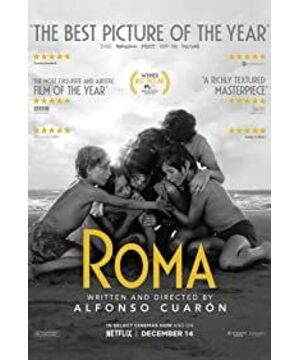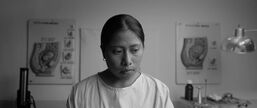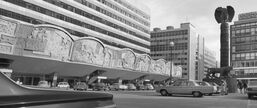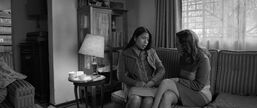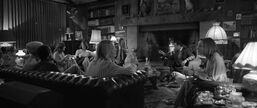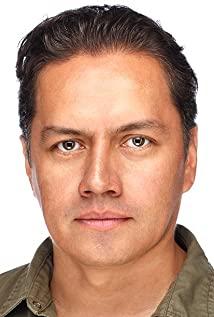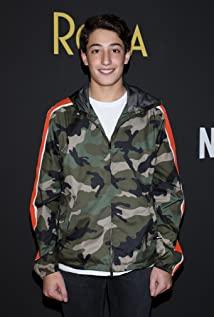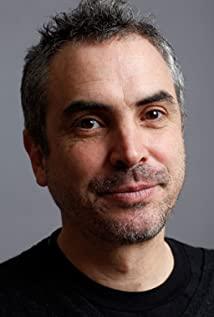"No matter what you are shooting, you must have a basic expected picture in your heart." Alfonso Cuarón said while sitting in the office. , So it’s not easy to go wrong in the post-shooting process."
Just like "Son of Humanity", the image that Caron expected was a pregnant black woman, hesitating and looking ahead firmly.
In "Rome," he said, "The scene that triggers the overall narrative is the scene where Cleo walks from the metal staircase to the roof, opening the skylight of memories."
The film "Rome" does not need to be introduced by the author. Most readers know that the story takes place in an old neighborhood called Rome in Mexico City in the 1970s. The film is a love letter written by the director Caron to his nurse.
When Karon was a child, she was unmarried and conceived first. She has experienced the turmoil of the times and the joys and sorrows of her life. She has never left since she took care of the Karon family in her twenties. When Alfonso was planning to make this movie, he said to his brother Carlos: "I want to make this movie. It's because I know that I have to make such a movie in my life, even if there is no audience."
At present, the film has appeared in major film festivals. To the amazement of international film critics and audiences, Netflix and the theater owners have reached an agreement to be screened simultaneously in the United States and 190 countries/regions worldwide in December.
Judging from the trend of Netflix moving closer to traditional Hollywood film companies, the film "Rome" is indeed highly likely to be successful. When "Rome" finally officially opens to the public, you might as well follow Caron to pull the film.
1. The construction of the script
In determining the main structure of the story of "Rome", Alfonso Calongo Participant Media boss David Linde (David Linde) met in a tea shop in London. Caron spent ten minutes talking about it, asking David Lind for about $15 million. The subsequent dialogue will end in less than three minutes.
"At that time Linde asked'when will you start?' I said that if your company gives me the green light now, I can start immediately. Then Linde said he would join in very readily. I made a request at the time, except for him. Apart from me, don't mention my script to anyone, not even the employees of the company." Caron laughed with his palms, "The reason is simple, because I haven't written the script yet."
Although the script did not even have a prototype at the time, there are three benchmarks for the film that are very clear in Caron's mind:
1. This story belongs to "Cleo" in real life, and her experience is the soul of this movie;
2. To write a movie with memories, every little detail that existed in the past is vital to the narrative;
3. The picture of "Rome" must be black and white, in essence it is closely connected with the past. It is shot with a 6K digital 65mm camera to enhance the sharp expression of the picture in the subtleties.
"When I set the main tone of the movie, many narrative arrangements were completed. The metal staircase leads to memory. The immersive feeling brought by the black and white pictures is part of Cleo's experience memories. There is no doubt that."
Caron paused, "From the perspective of the entire script, there is no so-called A and B lines. This is not a dual-track story. It just embeds a personal experience in a grand social perspective."
Caron is careful to ensure that the film’s deep personal imprint, the motif of the entire film is actually rooted in a strong theme pillar, which is where some fictional elements play an imaginative role in the film.
"Between individuals and groups, film creators must have a good idea and a balance between the two. What is the narrative ratio. This also involves emotional control. Because the personal scars we are talking about are not Unique to an individual, any individual’s experience is related to the situation in which he is in."
"The era in which the film takes place is definitely a period that scars any individual. We can assume that everyone's experience is different and the pain they endure is different. However, the social events depicted in the film undoubtedly existed in Mexico. One of the most important and deepest scars in the collective consciousness of people. From my current point of view, this also gives me the opportunity to reintegrate into this community after 18 years away from home, and experience it with other Mexicans. This experience."
The film "Rome" uses Cleo's perspective to refine the macro proposition of society. This role undoubtedly plays a core and catalyst role in the key drama. When making the background of this movie, considering the complexity of "Cleo" from personal to social background in many aspects, Caron made multiple designs on the characters.
He said, "In the process of shaping the character of'Cleo', the only thing I am interested in is that the matter of'creating a familiar character image' itself is full of contradictions. Because of the various characteristics of this character, It’s all taken for granted in the eyes of creators, and you won’t really give them a brand new personality."
"In fact, what we need to do is to take a serious look again. Just like Mexico City, where I grew up, when I didn't expect to return to this city 18 years later, many things that were accustomed to it now seem to be so different. I think people will always change their views of things around them with age and experience."
"In order to create this character, I talked a lot with Cleo in reality. It felt like I was really approaching her for the first time in my life, treating her as a woman, a woman in a complicated situation, and a woman from a disadvantaged position. Group women are also disadvantaged women in a society dominated by classes. Through the use of characters to infer the narrative background, dramatic conflict points immediately surfaced."
The same thing as in "Your Mother" is that "Rome" also adopts a theme-driven intensive narrative model. At this point, compared with all previous Mexican drama films in Caron, this is a particularly obvious author style. "The same is true for your mother" also avoids the description of the general environment, and instead uses the story of a pair of good friends with the goddess in the dream on a road trip, which brings out the fragility of Mexico before the social and economic collapse in the details.
Looking at the works of Alfonso Cuarón, there is basically no ambiguity in gender, and the binary distinction between the two sexes is very clear. Even so, when it comes to shaping the roles of both sexes, "Rome" is still obviously one-sided in handling male roles compared with previous works.
The overly outstanding female aura and tone in the film "Rome" relatively reflect the cowardice of male roles and the lack of patriarchal image under social conflict. This is a significant gap between the male images with active and resisting life traits in the previous "The Same Your Mother" and "Love is in Hysteria".
To some extent, Caron’s long-term creations are biased towards gender extremes. The obvious positive feminist views in "Rome", "Little Princess" and even "Son of Humanity" are similar to those in "The same as your mother" and "Love in Love". The black humor achieved by the excessive display of masculinity in "Hysterical Time" ("Harry Potter" and "Great Expectations", works with profound original authorship are not discussed here). Caron is keen to sharply challenge the traditional concept of masculinity, and also brings a distinctive atmosphere to his works.
When creating the script, the multiple scrutiny of the characters is also one of the important tasks when Caron structured the basic context of the film. Neither "Son of Man" nor "Gravity" are pure science fiction movies. These films show metaphors and visual textures through the eyes of the protagonist, so as to serve the emotional reaction of the audience.
When the audience fully penetrates into the picture of "Gravity", their senses will unconsciously follow Clive Owen or Sandra Bullock floating in space, using visual and auditory senses to touch the crisis shown in the film Sense and psychological vulnerability, these are the effects of the comprehensive expression of audiovisual language set in the early stage of the script.
The film "Rome" also operates in accordance with this logic, inducing the audience's sense of immersion and psychological identification through a large number of detailed settings, substituting the parallel impermanence caused by Cleo's individual fate and social turmoil. This collapse of stability under the accumulation of subtleties is far deeper than the hysterical reversal.
Caron said, “Making every movie is a curious experience. I will do a lot of research before shooting the movie. "Gravity" is a study of space technology. When filming "Son of Man", I Studying thinkers’ predictions about the future direction of the 21st century."
"But "Rome" is different. This film is a collaboration with my own past and directly faces my own past. This makes me have to explore a more private private field. 90% of the scenes in the film are in my There is no trace in the memory. More directly, in fact, this movie is also a process of reshaping oneself and reshaping collective memories."
"In this case, all research is introverted exploration," Caron said. "Most of these characters have really existed in real life. They are people I love deeply; so much so in filming. In the process, I always involuntarily traversed my personal memories, traversed the maze of memories, and talked with people who turned into historical dust all night long."
2. The shooting process
The film "Rome" is the first feature film of Alfonso Cuarón's own name in the photographer's column. "When this film was written for the screenplay and the storyboard, in fact, many of the lens details were Lubetz. Designed by Ki.” (Emanuel Chivo Lubetski, Alfonso Cuarón’s royal photographer. Except for "Harry Potter 3", the rest of the films were completed by the two together).
Naturalistic shooting, Arri Alexa 65mm digital camera, black-and-white images, Karon and Lubbecki have already determined these general directions in the discussion meeting before shooting. "Of course I want the film to look like the old days, but this is by no means nostalgic or deliberately making the picture old, so I didn’t use film to shoot, I don’t need those graininess. It is just like other films, it is memory and The current game, that dynamic sense of fluency, is like bringing people back to flowing memory."
The film "Rome" was prepared for nearly a year in the early stage of shooting, which was much longer than the expected shooting cycle. This also caused the original photographer to have no schedule to continue filming for "Rome" after a few weeks of preparation. As a result, Caron himself had to set up two borrowed Arri Alexa cameras alone and shoot the movie himself.
"Becoming a photographer of "Rome" was an accident in the shooting process." Caron said, "Of course, the successful completion of "Rome" is inseparable from Lubetsky's preparatory work. When he left the crew, The preparation work is approaching the stage before shooting, and I don’t want to hire a photographer who speaks other languages, because I only know how to express a lot of sensual things in my native language, and the meaning will change if I translate it again, so in the end, Decide to take the shot for yourself."
"But this kind of change is actually beneficial, because before I told Lubbecki about the camera position, lens shifting, and splitting, I can safely hand it over to him and don't care about that much. For the second time, because you need to rely heavily on the flow of personal emotions and memories, you can take into account various elements during the shooting, including the state of the actors, light, etc., in person, and the rhythm and position of the mirror will be closer to the preset in the brain. Idea, this is very good."
In fact, before and after the infinitely naturalistic filming, the behind-the-scenes team has made a lot of effort in choosing the shooting location and preparing for the actors, repeated auditions, and selected non-professionals to play their real-life "roles" in the film. It means that the rest of the film creation needs to be highly coordinated. The use of natural light and the ratio of sound effects not only form a unified language style in the film, but also must be reasonable in the actual imaging.
"For the actors' performance, my other principle is that they need a real life state. I will not tell the actors what to do, because they know life itself better than I do." Caron said, "I can't tell the film. What questions should the'gynecologists' in China ask their patients? Their life experience is more important."
Many close-up shots and bird's eye views in the film have profound implications, and Caron undoubtedly saves the best for last. A breathtaking long shot of a family walking back and forth between the beach and the big waves, and the sunset behind them stretches the horizon infinitely into the future.
“It took a long time to find this shooting location. Many shooting locations, such as the beach and picnic grass in the photo, involve environmental elements and lighting issues. I have to say that we are lucky. Almost every time we shoot, it’s perfect. The light will appear there. Just like the scene on the beach, the family walked to the edge of the horizontal line, and the sunset light line is falling behind them. These are natural gifts.
For another example, to capture the status of a character, the creator must be highly concentrated, because many opportunities are fleeting. "Just like in the scene of'Announcement of Divorce', the camera winds in and out of multiple characters, like walking in a circling, flowing dance step. This long shot was taken more than 60 times in two days. The conversations and shots of the children The rhythm of the movie, the changes in light, the emotions of the characters, including my breathing when I was in the mirror... All factors will directly affect the uniform style and atmosphere of the movie. When the long shot came to the end, Sophia told the children that she was divorcing her husband, After capturing the character's state, I breathed a sigh of relief."
Another example is, "When shooting a picnic in the forest, I divided the actors into several groups. Each group held a specific script. They were not allowed to communicate with each other, and they would not know the content of the scripts of other groups. The scene was plunged into chaos, and the mess of life brought about by this veil of ignorance was the true sense of life."
"A lot of people might think of Jean Renoir's "The Rules of the Game" from my movie." Caron said, "But it's not just Renoir. If I realized when I was filming that other directors in film history might have used it. I will also deliberately avoid it. Nevertheless, there are many classic movies that flow in the blood of filmmakers like DNA. It is impossible for me to take a picnic, river or stairs to check the history of the film, so I found that there are similarities. The place is actually normal."
In order to make the scene and location as close as possible to the director's memory, artistic director Eugenio Caballero's team rebuilt the home in the film "Rome" in an abandoned house. "Eugenio recovered about 70% of the discarded furniture, almost resetting his new home.
Many places where the camera would not appear, like the drawers in the closet, are filled with daily necessities, just to feel at home. "Caron said. The surprising opening shots of the aircraft reflected in the water stains on the garage floor were drawn by the VFX artist based on the outline of the aircraft at that time."
As far as the reputation of "Rome" in the public and critics is concerned, judging from the current international forecasting trend, as Netflix is getting closer to the traditional forces of Hollywood, the award for the best foreign language film is naturally higher. But awards are nothing more than the icing on the cake, and the quality of the film is the only criterion for staying alive.
Here is a list of the five best personal film history of Alfonso Cuarón to see how this great director develops his personal film-viewing taste:
Five Best Film History of Alfonso Cuarón
1. "Journey to the Moon" (1902, George Mélière)
2. "Chang'e in the Moon" (1929, Franz Lang)
3. "Blue Fireworks" (1969, John Sturges)
4. "Apollo 13" (1995, Ron Howard)
5. "Space Pioneers" (1983, Philip Kaufman)
Reference:
1. "Director Alfonso Cuarón Reveals WhyHe Kept His Passion Project'Roma'", 2018. 09, Damon Wise, Deadline.com
2. "AlfonsoCuarón Talks'Roma'", 2018. 07, Zach Sharf, IndieWire Medias Inc.
3. “How'Roma' Pushes the Envelope for Alfonso Cuarón”, 2018. 09, Film School Rejects
4. "Alfonso Cuaron Says Yes, People ToldHim He Was Nuts to Make'Roma'", Steve Pond, 2018.09, The Wrap Media Inc.
Compilation | Peter Pan; Public Number | Watching a movie and seeing death
Edit | Riding a Rooftop Boy; please indicate the source for reprinting
View more about Roma reviews


